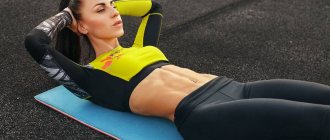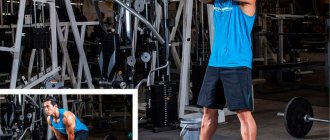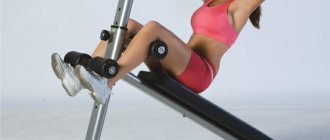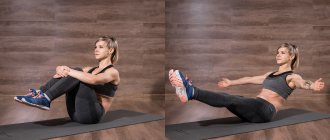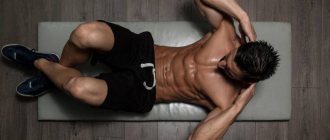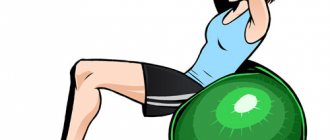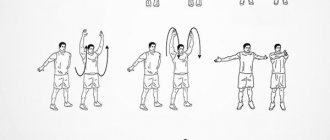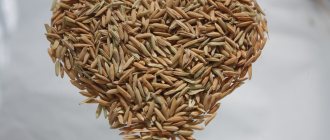The main function of muscles is movement and stabilization. The spine is held by the back muscles at the back and the abdominal muscles at the front. This is an important, very well-developed and compensatory mechanism of our body. Weakness of the abdominal muscles is one of the first causes of pain not only in the abdominal and groin area, but also back pain.
Clear, simple exercises will help restore abdominal muscles after operations, injuries and prolonged immobilization.
Clothes should be loose, it is advisable to remove shoes. Perform all exercises (especially the first days) smoothly and gradually. Remember the important principle: “Endure mild pain, do not allow severe pain.”
Do these exercises daily for at least 2 weeks.
Beetle movement
Lying on your back, legs bent at the knees, arms along the body.
Tighten your abdominal muscles. While maintaining tension, lift one bent leg a few centimeters from the floor and hold it for 5 seconds, then lower it. Repeat the exercise with the second leg. Then raise your arm above your head and hold it for 5 seconds. Then lower and repeat the exercise with the other hand. Repeat 5 times with each arm and leg. As soon as the exercise ceases to be difficult for you, begin to lift your leg and the opposite arm at the same time. Hold also for 5 seconds. 3 sets of 5 reps on each side.
Transverse abdominis muscle: its function
Contrary to popular belief, it is not the abdominal press (a six-pack) that is responsible for a flat stomach, but the underlying muscle – the transverse abdominis. It is this that prevents the internal organs from protruding forward, maintaining their correct position inside and preserving the aesthetics of the abdomen.
This muscle is also responsible for posture, no matter how strange it may sound. It is precisely because of the weakness of this muscle (they pay little attention during training and do not use it in everyday life) that problems with the spine, in particular with the lumbar region, can begin. It's simple: the transverse muscle is relaxed, the load of the entire body is transferred to the spine, which is why over time, step by step, protrusions and then hernias develop (in people with a weak spine, as a rule).
Transverse abdominis muscle
– this is a deep-lying muscle (right under the six-pack abs, i.e. the rectus muscle and the oblique muscles). This muscle is one of the most important in the core musculature. Responsible for posture and, roughly speaking, the health of the spine.
Twist
Lying on your back, legs bent at the knees, arms along the body.
Tightening your abdominal muscles, lift your shoulder blades off the floor and stretch your arms towards your legs. Hold the achieved position for 3 seconds. Do not hold your breath. 2 sets of 15 times. If you clasp your hands behind your head and spread your elbows to the sides, the effectiveness of the exercise increases significantly. Start doing the following exercises when you get used to the previous ones. Recommended 1 week after the start of classes.
Workout for internal abdominal muscles
Workout for internal abdominal muscles
Do you want to get sculpted abs? Then get ready for some serious work on your internal abdominal muscles! I will make your task easier and tell you how to perform the most effective exercises.
Abdominal muscles: a little anatomy
The rectus muscle stretches along the entire length of the abdomen, starting in the area of the pubic bone. On the front of the abdomen, sides and part of the chest is the external oblique muscle, which is considered the largest in width of all the muscles of the abdominal region.
Below is the internal oblique abdominal muscle, which is the second muscular layer of the abs, and below it is anatomically located the transverse abdominal muscle, which tightens the ribs and makes the abdominal cavity smaller.
How to pump up your abdominal muscles?
If the internal abdominal muscles are too weak due to lack of training, they do not sufficiently hold the internal organs, and therefore the stomach becomes rounded and bulging. This causes considerable discomfort to a person, forcing him to resort to various types of exercises.
What muscles should you work on the most? First of all, this is the rectus abdominis muscle - the place that everyone calls the “abs”. This is what most exercises do. It is this muscle that is divided into “cubes” that all men dream of acquiring.
To develop the external oblique abdominal muscle, it is necessary to use any variation of lateral bending and lateral twisting. Just don’t lose sight of the fact that, firstly, too active work on this muscle gives the figure a disproportionate appearance due to an increase in the waist, and secondly, exercises with crunches do not train the internal oblique and transverse abdominal muscles.
How to get a toned stomach
If you want to get not only a six-pack, but also a sculpted, toned stomach, then you will have to additionally work out the internal abdominal muscles. It is with their help that a muscular frame is created and the torso looks more athletic due to the tightening of the body.
Exercises for the internal abdominal muscles are static, which is the main difference between them and exercises for the external abdominal muscles. First of all, you must learn to feel these muscles, and then learn to keep them tense for as long as you can.
Exercise “Vacuum in the stomach”
Starting position: lie on your back, bend your knees and place them on the floor, place your hands at your sides. Now you need to exhale the air from your lungs and strongly draw in your stomach. Stay in this position for as long as possible, then inhale and repeat the exercise.
Strive to ensure that you can not only draw in your stomach as you exhale, but also breathe in “small sips” while you are tense. Tighten your muscles longer each time, and also try doing the exercises while sitting or standing.
Exercise "Plank"
Starting position: lie on your stomach, leaning on three points: elbows parallel to each other, knees and toes. Tighten your abdominal muscles, as well as your core and buttocks, and lift your knees off the floor so that your body is in a straight line. Stay in this position for a few seconds.
You should alternate both exercise options (using a plank with an arm extension or a side plank) and the level of load: either simply use the maximum repetition time, or use the load at intervals (you do the exercise for 10 seconds and rest for 2 seconds), trying to do more repetitions.
An integrated approach to working out the abs
It is best if you train your internal abdominal muscles every day during your morning warm-up. After just a few weeks of regular exercise, pleasant changes in the tone of the core muscles will become noticeable, and the abdominal muscles will be thoroughly toned.
Do not forget that not a single abdominal exercise can burn fat in the abdominal area. If you want to really improve your abdominal contour, then first go through a set of workouts to burn excess fat.
By training your internal abdominal muscles with static exercises, you can end up with a more athletic figure and toned abdominal muscles. Train for 5 minutes every day, and positive results will not take long to arrive!
Side twist
Lying on your back, legs bent at the knees, arms along the body. Tightening your abdominal muscles, lift your shoulder blades off the floor and stretch your arms towards your legs, turning your body to the right. Hold the achieved position for 3 seconds. Do not hold your breath, do not help yourself with your hands. Then return to the starting position. Repeat the exercise 15 times in each direction. 2 sets of 15 times. If you clasp your hands behind your head and spread your elbows to the sides, the effectiveness of the exercise increases significantly.
Exercises for the transverse muscle
Weak transverse muscles are a common problem for people who spend most of the day sitting and do not exercise their abs. The presence of visceral fat also negatively affects the tone of the internal abdominal muscles, stretching them. That is why it is important to strengthen the internal muscles with exercises:
Lifting arms and legs while lying down
Starting position: lying on your stomach, arms and legs extended. Tighten your abs, pull in your stomach, then slowly lift your arms and legs about 30-40 cm up. Hold for 1-2 seconds and return to the starting position. Perform 3-4 sets of 8-12 repetitions.
// Exercises to strengthen the lower back
Lying oblique crunches
Starting position - lying on your back, one leg bent at the knee on the floor, the other laid up. Hands behind your head - but without excessive pressure. As you exhale, slowly reach your elbow toward the opposite knee, contracting your abs. Perform 2-3 sets of 12-15 repetitions on each side.
// Oblique abdominal muscles - how to pump?
Pulling your knees to your chest
Starting position - lying on your back, legs bent at the knees and raised up. The abs are pulled out in a line, the buttocks are slightly lifted off the floor. Using the strength of the transverse abdominis muscle, slowly pull your knees towards your chest, then return to the starting position without losing muscle control. 3-4 sets of 12-15 repetitions.
// How to pump up your lower abs?
Advanced crunches
Starting position - similar to the previous exercise. Place your hands on your head. Slowly lift your upper body, directing your elbows toward your knees—contracting your abs as much as possible as you crunch. Make sure that your hands do not put pressure on your head. Perform 3-4 sets of 12-15 repetitions.
// Crunches - how to do them correctly?
Regular crunches
After a more complicated variation of the exercise, perform classic crunches, but with an emphasis on the work of the transverse muscle. To do this, as you rise up, exhale the air from your lungs as much as possible, imagining that your waist circumference is decreasing as much as possible.
Spinal deflection while lying down
An exercise to cool down and develop spinal mobility. Lying on the floor with your stomach down, use your back muscles to lift your upper body. Do not push with your hands, use them only for support. Pause at the top, tensing your abdominal muscles. 2-3 sets of 30-60 seconds
How to pump up your abs at home?
Sample training program
One of the popular ab workout routines at home is called “10 levels,” or “6 pack of hell,” and consists of 10 bodyweight exercises. It does not require a personal trainer or professional equipment.
With regular training, the athlete moves from the initial level to more and more complex ones. Level exercises must be performed only in the specified sequence. As soon as you learn to perform the exercise without tension, move on to the next level.
- Pulling your knees to your chest in a sitting position. At the initial stage, 1 set of 10 repetitions is enough. Middle stage – 2 sets of 25 repetitions. Advanced – 3 sets of 40 repetitions. As the muscles strengthen, the range of movements increases. Then they move to the 2nd level.
- Raising the knees from a sitting position. Similarly, the load is increased to 3 sets of 35 repetitions.
- Raising bent legs from a lying position. 1st stage - 1 set of 10 repetitions, 2nd - 2 sets of 15 repetitions, 3rd - 3 sets of 30 repetitions. As the muscles strengthen, the angle of leg flexion is reduced to 45°.
- Frog leg raise. Starting position – knees bent at right angles and turned to the sides, feet and arms straight on the floor. Pull your feet towards you so that your heels remain pressed together. Tighten your abdominal muscles, lift your shoulders and arms off the floor. Hold the position for a few seconds. Then straighten your legs at an angle of 45 degrees to the floor, spreading your toes at an angle of 90 degrees to each other (heels together). Stage 1 – 1 set of 8 repetitions, 2nd – 2 sets of 15 repetitions, 3rd – 3 sets of 25 repetitions.
- Straight leg raises from a lying position. It is important to avoid even slight bending of the limbs at the knees. 1st stage – 1 set of 5 repetitions, 2nd – 2 sets of 10 repetitions, 3rd – 2 sets of 20 repetitions. As the muscles strengthen, the amplitude increases.
- Hanging knee raises. In this case, the thigh and shin should form a right angle. 1st stage – 1 set of 5 repetitions, 2nd – 2 sets of 10 repetitions, 3rd – 2 sets of 15 repetitions.
- Hanging bent leg raises. Bend your legs at the knees. Raise them parallel to the floor and lower them perpendicular to the floor without straightening them. 1st stage – 1 set of 5 repetitions, 2nd – 2 sets of 10 repetitions, 3rd – 2 sets of 15 repetitions.
- Hanging leg raises "frog". Straight legs are raised parallel to the floor, and then lowered not completely - at an angle to the floor. Stage 1 – 1 set of 5 repetitions, 2nd – 2 sets of 10 repetitions, 3rd – 2 sets of 15 repetitions.
- Partial hanging straight leg raises. Starting position – raise your legs so that they form an acute angle in relation to the floor and an obtuse angle in relation to the body. Fix your body, then raise your legs higher so that they are parallel to the floor. Return to the starting position. 1st stage - 1 set of 5 repetitions, 2nd - 2 sets of 10 repetitions, 3rd - 2 sets of 15 repetitions.
- Hanging straight leg raises: The limbs and body should form a right angle. 1st stage – 1 set of 5 repetitions, 2nd – 2 sets of 10 repetitions, 3rd – 2 sets of 30 repetitions.
When you can easily perform level 10 home exercises with maximum sets and reps, your abs will be perfect.
Content
- About the abdominal muscles
- How to pump up your abs? Features of the training program
- Research on the effectiveness of abdominal exercises
- Sample training program
- Crunches on the upper block
- How to pump up your abs correctly?
The transverse abdominis muscle is located internally and supports the internal organs. Provides abdominal retraction.
The internal oblique muscles of the abdomen run diagonally from the sternum to the pelvis, and the external obliques are located above them. Both muscle groups provide flexion of the spine at the lower back and rotation of the body in both directions.
The rectus abdominis muscle sits on top of the transverse abdominis muscle. This is what is called “press” in everyday life. Attached to the sternum and pelvic bone. Maintains a straight back position and helps bend it forward. The transverse fibers crossing it form 6 cubes, so dividing the abs into upper and lower is a myth: the relief along the entire height is formed by a single rectus muscle.
Exercises
Now let’s move directly to the question of how to pump up the rectus abdominis muscle. There are two types of basic exercises that strain the entire surface of the abs, but strain some parts more.
The first type of exercise involves more of the lower abdominal muscles. This can be achieved by raising your legs, but at the same time fixing your torso. For example, you can raise your legs by resting your elbows on special bars with a soft cushion for your back. Here you can lift both bent and straight legs. It is important that the legs rise precisely due to the force of the press, and not just dangle by inertia. Also make sure that your legs do not go too far back, crossing the imaginary line when lowered from the pillow. If you hang on a horizontal bar, for example, and raise your legs to your arms, the entire abdominal area will be used. This exercise is very hard and requires strong abs.
The second type of exercise better tightens the upper abdomen. To do this, you need to raise your body, fixing your legs. This exercise can be performed simply on the floor, or on a bench. In gyms, you often see one person sitting on an incline bench and another throwing a ball to him. Thus, he catches the ball, throws it out with force and bends it. The press is always tense, which means it pumps better.
Questions often arise: “how to pump up the external oblique abdominal muscle”, “how to pump up the oblique abdominal muscles”, “how to pump up the lateral abdominal muscles”. To tone these muscle groups, you need to do body crunches. It is these exercises that engage the necessary muscles. For example, on an incline bench you can kind of describe a circle. In this exercise, both the rectus muscle and the obliques will be well loaded. To make it more challenging, pick up an athletic pancake. You can also do vertical crunches: just touch your elbow to your knee.
The best assistant in forming a beautiful abs is the “plank” exercise. The plank can be performed both statically and dynamically. The static plank is performed with emphasis on the elbows, the back is straight, the stomach is tense, the lower back does not collapse. To make the exercise more difficult, stand up from your elbow to your hand and back again. By the way, you can also load the oblique muscles in the plank. You need to aim your knees towards your elbows. You can stand in a side plank on one elbow, with one foot resting on the other. You can stand like this for 30 seconds or touch your side to the floor and straighten back. You can also load both the rectus muscle and the obliques. Standing in a side plank, touch your straightened leg with your straight hand. You will get something like a fold.
If you don’t know how to pump up the transverse abdominal muscle, then do a “vacuum”. The exercise is done like this: while standing or lying down, you need to exhale forcefully and stick out your stomach, and then forcefully draw in your stomach. This exercise will give a load to the soldiers of the invisible front - the transverse muscles located deep inside, because they form the abs.
There is no universal pill for pumping up your abs. Each person is unique, so he must, based on experience, select effective exercises for his abs. Choose your own path, don't look at others and never compare your cubes with others. And after maintaining the correct training schedule, you will see the long-awaited cubes in the mirror.
How to pump up your abs in the gym?
To quickly pump up your abs to a six-pack in the gym, a set of 3 exercises is enough.
Crunches on the upper block
Starting position - stand with your back to the upper block, spread your legs wide, bend your knees slightly and fix the position. Grasp the upper block with your hands, bend your elbows slightly and fix the position.
As you exhale, use your abdominal muscles to tilt your body forward. Mentally control muscle tension in the abdominal muscles. While inhaling, return to the starting position.
When performing crunches on the upper block, the angle between the body and the arms does not change, otherwise you will pump the latissimus dorsi muscles.
Tilts at the multistation block
Starting position – standing in a multi-station. The crossbar is on the navel line. Hand grip is in the center.
As you exhale, bend forward as deeply as possible. The arms are slightly bent at the elbows to relieve stress on the elbow joints. The back is rounded, especially at the bottom. While inhaling, return to the starting position. When using large weights, you can hang a “pancake” on the back of your belt.
"Woodcutter"
Starting position – standing sideways to the upper block. Grasp its handle with both hands. The legs are spaced wider than shoulder width and the knees are slightly bent.
As you exhale, pull the upper block to the opposite knee. While inhaling, return to the starting position. When performing, mentally control the tension of the oblique abdominal muscles.
When performing abdominal exercises, it is important that the loads be progressive.
Anatomy of the rectus abdominis muscle
The rectus muscle is a long and solid mass that protects the abdominal wall. She takes part in most movements associated with bending the body and breathing. Also, together with the lower back muscles, it helps stabilize the body and maintain a straight body position.
The peculiarity is that throughout its entire length it is intersected by tendon constrictions. Anatomically, the rectus abdominis muscle originates from:
- The outer surface of the costal cartilages has 5-7 ribs (three teeth);
- Xiphoid process.
Attached to the pubic ridge.
Anatomy of the rectus abdominis muscle picture diagram
